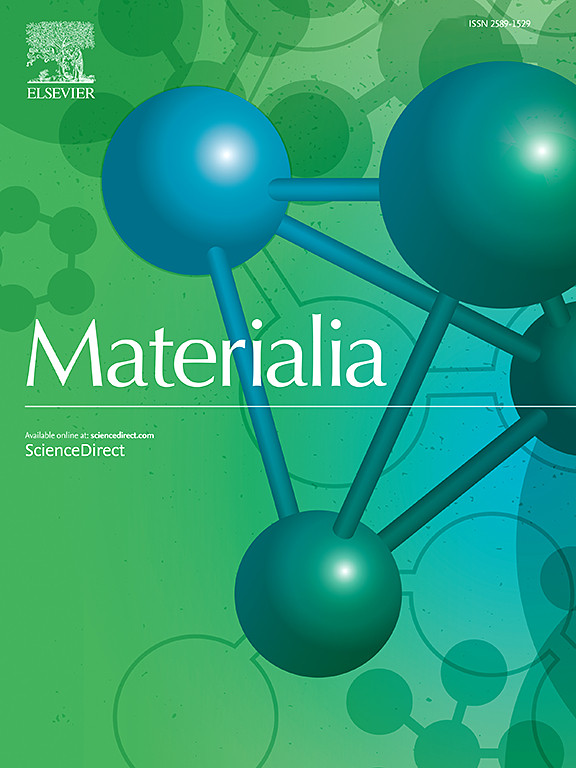Pd-decorated WO3 thin films deposited by DC reactive magnetron sputtering for highly selective NO gas with temperature-dependent tunable p-n switching
IF 3
Q2 MATERIALS SCIENCE, MULTIDISCIPLINARY
引用次数: 0
Abstract
This article reports on room temperature reactive magnetron sputtered Pd-decorated WO3 (Pd/WO3) thin films for NO gas sensing. The structure, morphology, and other physical properties of the sample were studied by XRD, FESEM, and XPS. NO gas sensing performance was evaluated across a range of operating temperatures (50–250 °C), and it was found that the sensor response was highly temperature dependent with p-n transition. Pd/WO3 thin film exhibited a typical p-type response to NO gas at lower temperatures (50–175 °C) but transitioned to an unusual n-type response at temperatures above that. Additionally, the ideal operating temperature for the p-type behavior was identified as 75 °C, whereas for the n-type behavior, it was 200 °C. The Pd/WO3, exhibiting p-type behavior, began responding to 50 ppm NO gas at a low temperature of 50 °C, achieving a sensor response (Rg/Ra) ∼ 8. The response peaked at ∼ 18 at 75 °C with a response and recovery time of ∼ 28 s and ∼ 88 s, respectively. In contrast, the n-type behavior showed a maximum sensor response (Ra/Rg) of ∼ 8.5 at 200 °C, with response and recovery times of ∼ 24 s and ∼ 12 s, respectively. This temperature-driven transition from p- to n-type behavior demonstrated high selectivity and stability for NO gas. The phenomenon was attributed to the formation of an inversion layer on the Pd/WO3 surface at lower temperatures caused by the adsorption of excess oxygen from the air.

用直流反应磁控溅射制备高选择性NO气体的pd修饰WO3薄膜
本文报道了室温反应磁控溅射Pd修饰WO3 (Pd/WO3)薄膜用于NO气敏。采用XRD、FESEM和XPS等手段对样品的结构、形貌和其他物理性质进行了研究。在50-250°C的工作温度范围内评估了NO气体传感性能,发现传感器响应与p-n转变高度依赖于温度。Pd/WO3薄膜在较低温度下(50-175℃)对NO气体表现出典型的p型响应,但在高于该温度时转变为异常的n型响应。此外,p型行为的理想工作温度为75°C,而n型行为的理想工作温度为200°C。Pd/WO3表现出p型行为,在50°C的低温下开始对50 ppm的NO气体做出响应,实现了传感器响应(Rg/Ra) ~ 8。在75°C下,响应在~ 18处达到峰值,响应和恢复时间分别为~ 28 s和~ 88 s。相比之下,n型行为在200°C时显示出最大传感器响应(Ra/Rg)为~ 8.5,响应和恢复时间分别为~ 24 s和~ 12 s。这种温度驱动的从p型到n型的转变表明了NO气体的高选择性和稳定性。这一现象归因于在较低温度下Pd/WO3表面由于吸附了空气中多余的氧气而形成的反转层。
本文章由计算机程序翻译,如有差异,请以英文原文为准。
求助全文
约1分钟内获得全文
求助全文
来源期刊

Materialia
MATERIALS SCIENCE, MULTIDISCIPLINARY-
CiteScore
6.40
自引率
2.90%
发文量
345
审稿时长
36 days
期刊介绍:
Materialia is a multidisciplinary journal of materials science and engineering that publishes original peer-reviewed research articles. Articles in Materialia advance the understanding of the relationship between processing, structure, property, and function of materials.
Materialia publishes full-length research articles, review articles, and letters (short communications). In addition to receiving direct submissions, Materialia also accepts transfers from Acta Materialia, Inc. partner journals. Materialia offers authors the choice to publish on an open access model (with author fee), or on a subscription model (with no author fee).
 求助内容:
求助内容: 应助结果提醒方式:
应助结果提醒方式:


